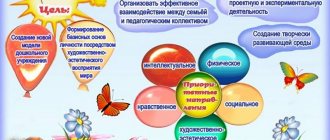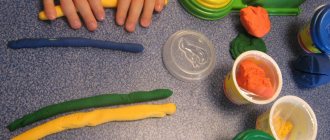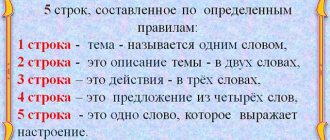Save article:
The article explains:
- The importance of early career guidance in preschool children
- Visual aids for career guidance for young children
- 5 interesting techniques for early career guidance for children
- Advice for parents on career guidance for young children
Career guidance for young children fosters a positive attitude towards work and allows them to try their hand at different types of activities.
The more a child knows about professions, the more clear the importance of work will be for them. The success of early career guidance depends on the fact that already in preschool age a sincere interest in the adult world appears. As a result of career guidance, children begin to become more interested in the activities of their own parents, and dynasties of doctors, teachers and engineers appear. Read more about what career guidance is for young children in our material.
The importance of early career guidance in preschool children
The first look at work and labor is very important for a child, because it significantly influences his understanding of the significance of the role of different professions in society.
The importance of early career guidance in preschool children
The whole world, society and, accordingly, the labor market are rapidly developing and changing. Of course, it is now unknown what will happen in ten years and what professions will be relevant and in demand. However, it is obvious that in such a dynamically changing world, a person’s flexibility, his ability to change the direction of career development and learn new things will be valued so that he can succeed in different areas and be realized in many of his endeavors.
This means that for modern children the factor of cognitive activity becomes very important, which determines the vector of efforts in preschool education.
And this is not about adults choosing a profession instead of a child even in preschool age, of course, but about giving the child a choice. So, it all starts with the child becoming familiar with work and professions in general. Only after getting acquainted with any field of activity, the child already learns new things and broadens his horizons. And the more such knowledge and skills he has, the easier it will be for him at a conscious age to choose a profession based on his skills and preferences.
Just as in the initial stages of career guidance, children are helped by their teachers, so they themselves become familiar with work through training sessions and various games.
Parents, of course, also actively participate in the development of their own children, helping teachers. By interacting with their parents, children learn new things, acquire norms of social behavior, improve communication and study skills, and, of course, get acquainted with work and various professions.
Early career guidance for preschool children in the context of the Federal State Educational Standard
Relevance and need for early career guidance for preschool children
The problem of career guidance is a public one, since the state of society, the development of the labor market, employment of the population, the ability to identify talents and direct them to the most suitable areas of activity depend on it.
What is career guidance? This is a system of activities aimed at identifying the personal characteristics, interests and abilities of each person in order to assist him in wisely choosing a profession that best suits his individual capabilities. According to the Resolution of the Ministry of Labor of the Russian Federation “On approval of the Regulations on vocational guidance and psychological support of the population in the Russian Federation” dated September 27, 1996 No. 1, vocational guidance is within the competence of preschool educational organizations. Kindergarten is the first important stage in preschoolers’ acquaintance with professions, which not only expands children’s general awareness of the world around them and their horizons, but also forms in them a certain elementary experience and promotes early professional orientation. The problem of introducing preschoolers to work has found a worthy place in the works of outstanding teachers of the past. K.D. Ushinsky considered labor as the highest form of human activity, in which the innate human desire to be and live is realized. A. S. Makarenko noted that proper education is necessarily labor education, since work has always been the basis of life. Teachers N.E. Veraksa and T.S. Komarov, recommend introducing children to the types of labor that are most common in a particular area. T.I. Babaeva and A.G. It is recommended to introduce Gigoberidze not only to the profession, but also to the personal qualities of representatives of these professions. Early career guidance is predominantly informational in nature (general acquaintance with the world of professions), and also does not exclude a joint discussion of the child’s dreams and experience acquired in some types of work activity (in terms of self-service, when performing feasible work). The relevance of work to familiarize children with professions is also justified in the Federal State Educational Standard for preschool education. One of the aspects of the educational field “Socio-communicative development” is aimed at achieving the goal of developing a positive attitude towards work. The federal state educational standard of preschool education defines Target guidelines at the stage of completion of preschool education, some of which are aimed at early career guidance of preschoolers: - the child masters the basic cultural ways of activity, shows initiative and independence in various types of activities - play, communication, cognitive and research activities, design and etc.; is able to choose his occupation and participants in joint activities; - the child has a positive attitude towards the world, towards different types of work, other people and himself, has a sense of self-esteem; actively interacts with peers and adults, participates in joint games. Able to negotiate, take into account the interests and feelings of others, empathize with failures and rejoice in the successes of others, adequately expresses his feelings, including a sense of self-confidence, and tries to resolve conflicts. Familiarization of preschoolers with professions is carried out taking into account the principle of integration of five educational areas in accordance with the Federal State Educational Standard for Educational Education, age capabilities and characteristics of pupils. The main difficulty in introducing children to professions is that a significant part of the work of adults is not available for direct observation. Information and communication technologies involve modeling various professional situations that would not be possible to recreate in a kindergarten setting. Therefore, to form children’s ideas about different professions, teachers use ICT in their work. “Game is of great importance in shaping a child’s image of the world. It is in the game that the first foundations of professional activity are laid, but they are laid only as opportunities to take on different professional roles. Figuratively speaking, children's play is the child's first career guidance. In the game, the child learns the possibility of being, ... being a captain, a doctor, etc.” (A.G. Asmolov) Most of all, preschoolers love to play. Play is the leading activity of a child. In games, preschoolers reproduce everything that they see around them in the life and activities of adults. What do famous teachers and psychologists say about children's play? V.A. Sukhomlinsky wrote: “Without play there is and cannot be full-fledged mental development. A game is a huge bright window through which a life-giving stream of ideas and concepts flows into the child’s spiritual world. Play is the spark that ignites the flame of inquisitiveness and curiosity.” The school of properly guided play opens a child's window into a world wider and more reliable than reading. (Fabre J.) Children's play often has a deep meaning. (Schiller I.) Many children's games are imitation of the serious activities of adults. (Korchak Ya.) Play is important in a child’s life, it has the same meaning as activity, work, service for an adult. What a child is like at play, so in many ways he will be at work when he grows up. Therefore, the education of a future leader occurs primarily in play. (Makarenko A.S.) Game is a reflection of life. The vast majority of children's games are devoted to displaying the work of people of different professions, so it is most advisable to carry out work on early career guidance for preschoolers through the organization of gaming activities. It is important that a child from an early age develops respect for any profession, and understands that any professional work should bring joy to the person himself and be useful to those around him. Thus, the formation of preschoolers’ ideas about the world of work and professions is a relevant process in the modern world, which is necessary build taking into account modern educational technologies. 1. Technology of project activities (L.S. Kiseleva, T.A. Danilina, T.S. Lagoda, M.B. Zuikova). Project activity is an activity with a specific purpose, according to a specific plan, to solve search, research, and practical problems in any area of educational content. 2. Technology of research activities (A.I. Savenkov, N.A. Korotkova). Research activity is a special type of intellectual and creative activity, generated as a result of the functioning of the mechanisms of search activity and built on the basis of research behavior. For research activities, types of research that are accessible and interesting to children of senior preschool age can be selected: - experiments (experimentation) - mastering cause-and-effect relationships and relationships; - collecting (classification work) - mastering genus-species relationships. 3. Pedagogical technology for organizing role-playing games (D.B. Elkonin, A.V. Zaporozhets, R.I. Zhukovskaya, D.V. Mendzheritskaya, A.P. Usova, N.Ya. Mikhailenko). A game is the freest, most natural form of immersion in real (or imaginary) reality with the purpose of studying it, expressing one’s own “I,” creativity, activity, independence, and self-realization. 4. The technology of integrated learning (L.A. Wenger, E.E. Kravtsova, O.A. Skorolupova) is a kind of innovative for preschool institutions. Integration is a state (or a process leading to such a state) of connectedness, interpenetration and interaction of individual educational areas of the content of preschool education, ensuring integrity. Based on the analysis of the studies studied and taking into account modern educational technologies, it is possible to determine the purpose and objectives of the work on early career guidance for children. Goal: to form in the child an emotional attitude towards the world of professions, to provide him with the opportunity to use his strengths in available activities. Objectives: – to enrich and concretize children’s ideas about the professional activities of residents of the city of Nizhnyaya Salda, to cultivate interest in the industrial enterprises of our city; – to form in children generalized ideas about the structure of the labor process, the role of modern technology in human labor activity, an understanding of the relationship between the components of labor activity; – strengthen children’s skills to express their impressions in playful and productive activities; – stimulate the development of children’s cognitive, communicative, and creative abilities; – cultivate a caring attitude towards the work of adults and its results; – help children understand the importance, necessity and indispensability of each profession. Work on early career guidance for preschoolers is built taking into account the following principles: 1. The principle of personality-oriented interaction (organization of the educational process based on deep respect for the child’s personality, taking into account the characteristics of his individual development, and treating him as a conscious, full participant in the educational process). 2. The principle of accessibility, reliability and scientific knowledge. 3. The principle of openness (the child has the right to participate or not to participate in any activity, to provide or not to provide the results of his work, to provide as a result what he, and not the teacher, considers his achievement, to make a decision on continuing or completing the work) . 4. The principle of dialogicity (the ability to enter into a conversation about the performance of the work, the result obtained, prospects for continuing the work, social situations that contributed or prevented the desired result from being achieved). 5. The principle of actively including children in practical activities (excursion, observation, work assignments, conversations, entertainment, quiz, games). 6. The principle of reflexivity. It is fundamental for each child to understand himself as a subject of his own activities and social relations. As a result, the child develops an idea of himself, his capabilities, and his success. Thus, the ability to understand actions, self-assessment of results, and self-regulation of behavior is formed. 7. The principle of the regional component. Aimed at bringing educational and educational practices into line with the social order and financial capabilities of the region. The work is based on an organizational and content model of early career guidance for preschool children. Organizational and content model of early career guidance for preschoolers How interesting is it to tell children about different professions? — Show children how adults work. It is practically difficult to achieve quality educational services in the field of early career guidance for preschoolers without creating special conditions for close cooperation with social institutions. By social partners we mean specific people, professionals in their field, through whose images future preschoolers will be able to get acquainted with the variety of professions in our city! Recommendations for organizing social partnerships are on the slide. Close interaction with social partners will allow us to reach a new, innovative level of development of the preschool education system and will help create favorable conditions for educational activities, taking into account modern requirements for the development of children. “Happiness in a profession is when you do something that you are very good at, you like doing it, other people need it and you get paid for it.” Actually, it is precisely this formula that contains the list of questions that are usually asked to optants - young people making their first professional choice. So these are the 3 most important questions. Question 1. What can you do better than others? Question 2. What do you like to do? Question 3. How can you be useful to other people? What to do with these 3 lists? Each of these three lists can hardly be compiled at once; it is better to add to them over the course of a month. Then rank the answers in each list. Those “competitive advantages”, “attractive activities” and “useful things” that took places from 1 to 10 can be considered as 3 grounds for professional self-determination. “To reach the goal, a person needs only one thing. Go." (Honore de Balzac).
We recommend watching:
Summary of GCD in the middle group on the topic: Profession of a pastry chef Summary of the lesson in the middle group. Profession postman Targeted excursion to the kindergarten kitchen “What is the cook cooking for us for lunch?” Quiz game for children in the middle group of kindergarten on the topic: Professions
Similar articles:
Summary of lessons in kindergarten in the 2nd junior group. Doctor's profession
Lesson in the middle group of kindergarten. Professions of rural people
Children about the medical profession
Children about the lifeguard profession
About the profession of a museum worker for children
Visual aids for career guidance for young children
In the process of teaching children in general and in career guidance in particular, the factor of visibility is very important. Children learn any information better if you give a good example and clearly show them an illustration. Technical means help in this - from projectors to ordinary computers - and “classical” school tools: presentations, books and others.
Free online intensive
Your Path to IT starts here
More details
If you work well on the element of clarity and present children with relevant and correctly illustrated examples, you can really increase the effectiveness of training and career guidance. This makes it easier for children to be involved in the process, and they themselves better assimilate information, and their knowledge is not mixed into a single stream, but systematized.
- Technical equipment. The most common technical means used for preschool children are:
- Projector.
TV or computer monitor.
- Interactive board.
The interactive whiteboard allows you to present presentations, videos and various illustrations to children. Moreover, children can interact with various slides and animations - move objects, draw different shapes, flip through the slides. This way, the information that needs to be conveyed to children can be made not only more visual, but also more colorful, it is more memorable, because the children themselves are directly involved in the educational process. Moreover, this way you can involve the whole group, and not just the most active children, because it is similar to the format of the game and is interesting for all children.
Using a projector, children can be shown presentations and videos that will detail all the nuances of any profession. For example, a wide variety of slides or an interesting video will help children clearly see what the teachers are talking about.
On a TV or monitor, children can watch videos, films and cartoons that tell them about professions. More and more of these are produced every year, and many consider the career guidance cartoon “Kaleidoscope of Professions” to be one of the best. It is important to remember that after watching it, you must communicate with the children to find out how they understood the material, answer their questions, and thus better consolidate new knowledge.





